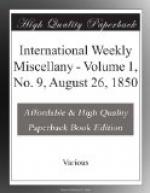“Makes a sort of gaseous grog of it, eh?” said Mr. Bagges. “But how is that proved?”
“Why, there is a gas, called nitrous gas, which, if you mix it with oxygen, takes all the oxygen into itself, and the mixture of the nitrous gas and oxygen, if you put water with it, goes into the water. Mix nitrous gas and air together in a jar over water, and the nitrous gas takes away the oxygen, and then the water sucks up the mixed oxygen and nitrous gas, and that part of the air which weakens the oxygen is left behind. Burning phosphorus in confined air will also take all the oxygen from it, and there are other ways of doing the same thing. The portion of the air left behind is called nitrogen. You wouldn’t know it from common air by the look; it has no color, taste, nor smell, and it won’t burn. But things won’t burn in it, either; and anything on fire put into it goes out directly. It isn’t fit to breathe, and a mouse, or any animal, shut up in it, dies. It isn’t poisonous, though; creatures only die in it for want of oxygen. We breathe it with oxygen, and then it does no harm, but good: for if we breathed pure oxygen, we should breathe away so violently, that we should soon breathe our life out. In the same way, if the air were nothing but oxygen, a candle would not last above a minute.
“What a tallow-chandler’s bill we should have!” remarked Mrs. Wilkinson.
“‘If a house were on fire in oxygen,’ as Professor Faraday said, ’every iron bar, or rafter, or pillar, every nail and iron tool, and the fire-place itself; all the zinc and copper roofs, and leaden coverings, and gutters, and pipes, would consume and burn, increasing the combustion.’”
“That would be, indeed, burning ‘like a house on fire,’” observed Mr. Bagges.
“‘Think,’” said Harry, continuing his quotation, “’of the Houses of Parliament, or a steam-engine manufactory. Think of an iron proof-chest no proof against oxygen. Think of a locomotive and its train,—every engine, every carriage, and even every rail would be set on fire and burnt up.’ So now, uncle, I think you see what the use of nitrogen is, and especially how it prevents a candle from burning out too fast.”
“Eh?” said Mr. Bagges. “Well, I will say I do think we are under considerable obligations to nitrogen.”
“I have explained to you, uncle,” pursued Harry, “how a candle, in burning, turns into water. But it turns into something else. besides that. There is a stream of hot air going up from it that won’t condense into dew; some of that is the nitrogen of the air which the candle has taken all the oxygen from. But there is more in it than nitrogen. Hold a long glass tube over a candle, so that the stream of hot air from it may go up through the tube. Hold a jar over the end of the tube to collect some of the stream of hot air. Put some lime-water, which looks quite clear, into the jar; stop the jar, and shake it up. The lime-water,




